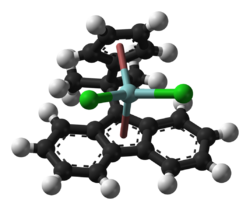Organozirconium chemistry
Topic: Chemistry
 From HandWiki - Reading time: 5 min
From HandWiki - Reading time: 5 min
Organozirconium chemistry is the science of exploring the properties, structure, and reactivity of organozirconium compounds, which are organometallic compounds containing chemical bonds between carbon and zirconium.[2] Organozirconium compounds have been widely studied, in part because they are useful catalysts in Ziegler-Natta polymerization.
Comparison with organotitanium chemistry
Many organozirconium compounds have analogues on organotitanium chemistry. Zirconium(IV) is more resistant to reduction than titanium(IV) compounds, which often convert to Ti(III) derivatives. By the same token, Zr(II) is a particularly powerful reducing agent, forming robust dinitrogen complexes. Being a larger atom, zirconium forms complexes with higher coordination numbers, e.g. polymeric [CpZrCl3]n vs monomeric CpTiCl3 (Cp = C5H5).
History
Zirconocene dibromide was prepared in 1953 by a reaction of the cyclopentadienyl magnesium bromide and zirconium(IV) chloride.[3] In 1966, the dihydride Cp2ZrH2 was obtained by the reaction of Cp2Zr(BH4)2 with triethylamine.[4] In 1970, the related hydrochloride (now called Schwartz's reagent) was obtained by reduction of zirconacene dichloride (Cp2ZrCl2) with lithium aluminium hydride (or the related LiAlH(t-BuO)3).[5][6][7] The development of organozirconium reagents was recognized by a Nobel Prize in Chemistry to Ei-Ichi Negishi.[8][9]
Zirconocene chemistry

The foremost applications of zirconocenes involve their use as catalysts for olefin polymerization.[11][12]
Schwartz's reagent ([Cp2ZrHCl]2) participates in hydrozirconation, which enjoys some use in organic synthesis. Substrates for hydrozirconation are alkenes and alkynes. Terminal alkynes give vinyl complexes. Secondary reactions are nucleophilic additions, transmetalations,[13] conjugate additions, coupling reactions, carbonylation, and halogenation.
Extensive chemistry has also been demonstrated from decamethylzirconocene dichloride, Cp*2ZrCl2. Well-studied derivatives include Cp*2ZrH2, [Cp*2Zr]2(N2)3, Cp*2Zr(CO)2, and Cp*2Zr(CH3)2.
Zirconocene dichloride can be used to cyclise enynes and dienes to give cyclic or bicyclic aliphatic systems.[14][15]
Alkyl and CO complexes
The simplest organozirconium compounds are the homoleptic alkyls. Salts of [Zr(CH3)6]2- are known. Tetrabenzylzirconium is a precursor to many catalysts for olefin polymerization. It can be converted to mixed alkyl, alkoxy, and halide derivatives, Zr(CH2C6H5)3X (X = CH3, OC2H5, Cl).
In addition to mixed Cp2Zr(CO)2, zirconium forms the binary carbonyl [Zr(CO)6]2-.[18]
Organohafnium chemistry
Organohafnium compounds behave nearly identically to organozirconium compounds, as hafnium is just below zirconium on the periodic table. Many Hf analogues of Zr compounds are known, including bis(cyclopentadienyl)hafnium(IV) dichloride, bis(cyclopentadienyl)hafnium(IV) dihydride, and dimethylbis(cyclopentadienyl)hafnium(IV).
Cationic hafnocene complexes, post-metallocene catalysts, are used on an industrial scale for the polymerization of alkenes.[19][20]
Additional reading
- Whitby, R. J.; Dixon, S.; Maloney, P. R.; Delerive, P.; Goodwin, B. J.; Parks, D. J.; Willson, T. M. (2006). "Identification of Small Molecule Agonists of the Orphan Nuclear Receptors Liver Receptor Homolog-1 and Steroidogenic Factor-1". Journal of Medicinal Chemistry 49 (23): 6652–6655. doi:10.1021/jm060990k. PMID 17154495.
- Kasatkin, A.; Whitby, R. J. (1999). "Insertion of 1-Chloro-1-lithioalkenes into Organozirconocenes. A Versatile Synthesis of Stereodefined Unsaturated Systems". Journal of the American Chemical Society 121 (30): 7039–7049. doi:10.1021/ja9910208.
References
- ↑ Ewen, J. A.; Jones, R. L.; Razavi, A.; Ferrara, J. D. (1988). "Syndiospecific propylene polymerizations with Group IVB metallocenes". Journal of the American Chemical Society 110 (18): 6255–6256. doi:10.1021/ja00226a056. PMID 22148816.
- ↑ A. Maureen Rouhi (19 April 2004). "Organozirconium Chemistry Arrives". Chemical & Engineering News 82 (16): 36–39. doi:10.1021/cen-v082n015.p035. ISSN 0009-2347. http://pubs.acs.org/cen/nlw/8216sci1.html.
- ↑ G. Wilkinson; P. L. Pauson; J. M. Birmingham; F. A. Cotton (1953). "Bis-cyclopentadienyl derivatives of some transition elements". Journal of the American Chemical Society 75 (4): 1011–1012. doi:10.1021/ja01100a527.
- ↑ James, B. D.; Nanda, R. K.; Walbridge, M. G. H. (1967). "Reactions of Lewis bases with tetrahydroborate derivatives of the Group IVa elements. Preparation of new zirconium hydride species". Inorganic Chemistry 6 (11): 1979–1983. doi:10.1021/ic50057a009.
- ↑ Wailes, P. C.; Weigold, H. (1970). "Hydrido complexes of zirconium I. Preparation". Journal of Organometallic Chemistry 24 (2): 405–411. doi:10.1016/S0022-328X(00)80281-8.
- ↑ Wailes, P. C.; Weigold, H. (1970). "Hydrido complexes of zirconium II. Reactions of dicyclopentadienylzirconium dihydride with carboxylic acids". Journal of Organometallic Chemistry 24 (2): 413–417. doi:10.1016/S0022-328X(00)80282-X.
- ↑ Wailes, P. C.; Weigold, H.; Bell, A. P. (1971). "Hydrido complexes of zirconium". Journal of Organometallic Chemistry 27 (3): 373–378. doi:10.1016/S0022-328X(00)82168-3.
- ↑ Negishi, Ei-Ichi; Takahashi, Tamotsu (1988). "Organozirconium Compounds in Organic Synthesis". Synthesis 1988: 1–19. doi:10.1055/s-1988-27453.
- ↑ "Discovery of ZACA reaction − Zr-catalyzed asymmetric carboalumination of alkenes". Arkivoc 2011 (8): 34. 2010. doi:10.3998/ark.5550190.0012.803.
- ↑ Jones, Christopher G.; Asay, Matthew; Kim, Lee Joon; Kleinsasser, Jack F.; Saha, Ambarneil; Fulton, Tyler J.; Berkley, Kevin R.; Cascio, Duilio et al. (6 September 2019). "Characterization of Reactive Organometallic Species via MicroED". ACS Central Science 5 (9): 1507–1513. doi:10.1021/acscentsci.9b00403. PMID 31572777.
- ↑ McKnight, Andrew L.; Waymouth, Robert M. (1998). "Group 4ansa-Cyclopentadienyl-Amido Catalysts for Olefin Polymerization". Chemical Reviews 98 (7): 2587–2598. doi:10.1021/cr940442r. PMID 11848972.
- ↑ Alt, Helmut G.; Köppl, Alexander (2000). "Effect of the Nature of Metallocene Complexes of Group IV Metals on Their Performance in Catalytic Ethylene and Propylene Polymerization". Chemical Reviews 100 (4): 1205–1222. doi:10.1021/cr9804700. PMID 11749264.
- ↑ Sun, Ruen Chu; Okabe, Masami; Coffen, David L.; Schwartz, Jeffrey (1997). "Allylic Alcohols by Alkene Transfer from Zirconium to Zinc: 1-[(tert-Butyldiphenylsilyl)oxy]-dec-3-en-5-ol". Organic Syntheses 74: 205. doi:10.15227/orgsyn.071.0083.
- ↑ Fillery, Shaun F.; Richard J. Whitby; George J. Gordon; Tim Luker (1997). "Tandem reactions on a zirconocene template". Pure and Applied Chemistry 69 (3): 633–638. doi:10.1351/pac199769030633.
- ↑ Negishi, Ei-Ichi (1991). "Zirconium-promoted Bicyclization of Enynes". Comprehensive Organic Synthesis. pp. 1163–1184. doi:10.1016/B978-0-08-052349-1.00149-9. ISBN 978-0-08-052349-1.
- ↑ Thomas, E.; Dixon, S.; Whitby, R. J. (2006). "A Rearrangement to a Zirconium–Alkenylidene in the Insertion of Dihalocarbenoids and Acetylides into Zirconacycles". Angewandte Chemie International Edition 45 (42): 7070–7072. doi:10.1002/anie.200602822. PMID 17009379.
- ↑ Rong, Yi; Al-Harbi, Ahmed; Parkin, Gerard (2012). "Highly Variable Zr–CH2–Ph Bond Angles in Tetrabenzylzirconium: Analysis of Benzyl Ligand Coordination Modes". Organometallics 31 (23): 8208–8217. doi:10.1021/om300820b. https://figshare.com/articles/Highly_Variable_Zr_CH_sub_2_sub_Ph_Bond_Angles_in_Tetrabenzylzirconium_Analysis_of_Benzyl_Ligand_Coordination_Modes/2461726.
- ↑ Ellis, J. E. (2003). "Metal Carbonyl Anions: from [Fe(CO)4]2− to [Hf(CO)6]2− and Beyond". Organometallics 22: 3322–3338. doi:10.1021/om030105l.
- ↑ Chum, P. S.; Swogger, K. W. (2008). "Olefin Polymer Technologies-History and Recent Progress at the Dow Chemical Company". Progress in Polymer Science 33: 797–819. doi:10.1016/j.progpolymsci.2008.05.003.
- ↑ Klosin, J.; Fontaine, P. P.; Figueroa, R. (2015). "Development of Group Iv Molecular Catalysts for High Temperature Ethylene-Α-Olefin Copolymerization Reactions". Accounts of Chemical Research 48 (7): 2004–2016. doi:10.1021/acs.accounts.5b00065. PMID 26151395.
16 views | Status: cached on August 23 2024 07:57:57
↧ Download this article as ZWI file
 KSF
KSF



